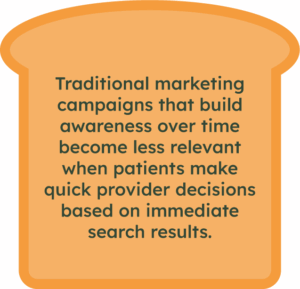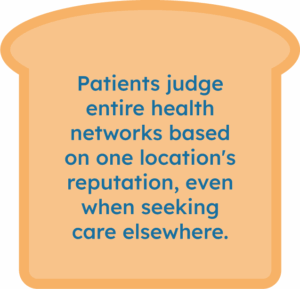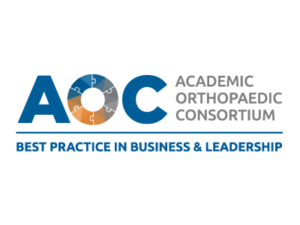Healthcare organizations spend millions on recruiting top physicians and upgrading facilities, yet many are losing patients before they ever walk through the door. The culprit isn’t poor medical care or ineffective advertising, it’s a misunderstanding of how patients actually choose providers.
Here’s what’s happening: we’re moving from a credential economy where medical degrees and hospital affiliations drove patient decisions, to a trust economy where peer experiences and digital reputation increasingly determine who gets chosen. This transformation is creating winners and losers across healthcare markets, often in ways that have nothing to do with clinical quality.
Where Patients Really Search
While healthcare organizations debate preparing for AI-driven search disruption, patients have already made their choice clear. Google receives approximately 373 times more searches than ChatGPT, and 5% of all Google searches are health-related. Nearly 80% of patients rely on online reviews to find healthcare services before making an appointment, and they overwhelmingly turn to Google for three critical reasons: trust in established search results, integration with Google Maps for location-based decisions, and the reliability of Google Business Profiles for provider information.
This preference isn’t arbitrary. Google was found to be the most accurate source for provider name, address and phone number compared to other directories. This accuracy builds the trust that keeps patients returning to Google for healthcare searches, even as AI alternatives emerge.
Another reason Google maintains its dominance over conversational AI (at least as far as the healthcare industry is concerned) becomes clear when you understand patient intent. Healthcare searches are fundamentally action-oriented. Patients need appointments, directions, and contact information, not conversational guidance. When someone searches “cardiologist near me,” they want immediate access to provider listings, reviews, locations, and phone numbers. Google’s integration with Maps, Business Profiles, and local data delivers exactly what patients need to take action, while conversational AI platforms are better suited for educational queries that don’t require immediate and actionable results.
The 24-Hour Revenue Window
Understanding Google’s dominance becomes financially critical when you consider that healthcare searches represent immediate need, not casual research. When patients search for providers, they act fast. Someone searching for a cardiologist on Tuesday morning is likely booking an appointment by Wednesday.
This urgency creates a compressed decision timeline that significantly changes how healthcare marketing should work. Every element of your digital presence, from your Google Business Profile to how you handle reviews—directly impacts revenue within hours, not months. Traditional marketing campaigns that build awareness over time become less relevant when patients make quick provider decisions based on immediate search results.
So what determines success in these lightning-fast decisions?
The Reputation Threshold

Healthcare organizations spend countless hours on strategy, but the patient’s choice actually boils down to something very simple: 75% of patients check Google reviews before choosing a provider, and 72% specifically seek four or five-star providers. This creates a binary outcome. You either meet the threshold and compete for patients, or you fall short and get ignored. There’s little middle ground in healthcare reputation.
For organizations that do meet the threshold, the benefits compound in ways most never anticipate.
The Hidden Multiplier Effects
Once you clear the reputation threshold, the benefits start compounding in ways that go far beyond individual patient choices.
Consider how this plays out with specialist referrals. Primary care physicians now routinely check online reputations before making referrals, which means specialists with stronger digital presence get more internal referrals. Those patients tend to be more satisfied (since they were referred rather than desperately searching), which generates more positive reviews, which attracts even more referrals. It becomes a virtuous cycle.
 This multiplier effect becomes even more powerful—and potentially more dangerous—for multi-location systems. Patients judge entire health networks based on one location’s reputation, even when seeking care elsewhere. A single location with poor review management can undermine patient acquisition across an entire system. But flip that around and the opposite is equally true. Master reputation management across all locations, and you see accelerated growth systemwide as each strong location reinforces the others.
This multiplier effect becomes even more powerful—and potentially more dangerous—for multi-location systems. Patients judge entire health networks based on one location’s reputation, even when seeking care elsewhere. A single location with poor review management can undermine patient acquisition across an entire system. But flip that around and the opposite is equally true. Master reputation management across all locations, and you see accelerated growth systemwide as each strong location reinforces the others.
If reputation creates all these advantages, why aren’t more organizations seeing the returns? The answer lies in what they’re measuring.
Organizations Often Measure the Wrong Things
Most healthcare organizations treat online reputation like a marketing “nice-to-have.” They see it as something that’s good for brand image but hard to measure in terms of actual ROI. Forward-thinking organizations, however, have found ways to trace reputation directly to revenue.
Instead of just tracking star ratings and response times, they’re asking harder questions like, “How much does each positive review reduce our patient acquisition cost?” and, “What’s the PLV difference between patients who found us through online reviews versus other channels?”
Organizations that track these metrics often discover that their digital reputation generates significantly better returns than traditional advertising.
The Strategic Framework for Success
Successfully managing your healthcare organization’s digital reputation comes down to four key areas.
Google Business Profile Management: Keep your profiles complete, accurate, and updated across all locations. This maximizes your visibility when patients search locally and gives them the information they need to choose you.
Review Generation: Use systems that make it easy for satisfied patients to leave reviews while staying compliant with healthcare privacy requirements. The goal is consistently hitting those four and five-star ratings that patients expect.
Review Response: Respond to every review professionally and promptly. Remember, most patients care more about seeing responses than the reviews themselves. Consider investing in software that automates this process so you never miss one.
ROI Measurement: Connect your reputation efforts to actual business results—patient acquisition costs, revenue growth, and referral patterns.
The Bottom Line
Success today requires more than clinical excellence. It demands systematic approaches to building and maintaining digital trust that directly drive patient acquisition and organizational growth.
The organizations that treat digital reputation as a strategic priority will thrive, while those that assume their medical credentials are enough will find themselves losing patients to competitors who understand what actually drives patient decisions.











